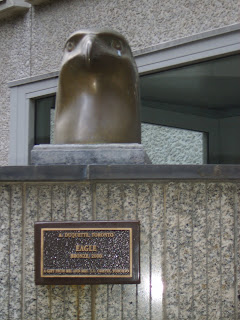Stoned - Part II Today we had a much smaller group - mostly thanks to the rain, which was persistent and occasionally very heavy. Undaunted we carried on.
Our first stop was Africa house, in Kingsway. The building gets its’ name from it’s association with the British Empire. Above the main entrance are two magnificent lions, then at the top of four columns are carvings of African faces and finally a large montage of animals, surrounding a Britannia like figure and which include a wildebeest, a crocodile, a lion and a dead elephant and the hunter who killed him. The artist is Benjamin Clemens (1875-1957) and his other works include sculptures at the headquarters of the Women’s Institute, the entrance to the Burlington Arcade and two lions at Woburn Abbey.

Africa House


Our next stop a few short metres away is at Imperial Buildings, built in 1913. There are two monuments here, one at the corner of the building and the other over the entrance. The first, at the corner depicts two figures - a woman carrying a quill signifying education and a man dressed as a roman soldier signifying the British Empire. The other monument also features a man and a woman. This time the woman carries a ship signifying trade and the man carries a hammer signifying industry. Both figures have a central shield with I B engraved for Imperial Buildings. These figures were made by L F Roslyn in 1914.


We then walked down Kingsway and into Portugal Street towards the London School of Economics. (LSE) Mr. And Mrs. Louis Odette of Toronto, Canada gifted the following three delightful sculptures to the university in 2006.
The first, Baby Tembo is of bronze and was made in 2002 by Derrik Hudson. The second, Penguin, is of painted aluminum, was also made in 2002 by Yolanda Vandergaast and the third, at the top of the steps down to St. Clements Inn is an Eagle also of bronze and made in 2000 by A. Duquette of Toronto.

Baby Tembo


Penguin

Eagle

We then walked back towards Lincolns Inn Fields to see the monument in the gardens to Margaret MacDonald. She was a noted feminist and socialist who lived from 1870 to 1911. She did a lot of work with children and was greatly loved by all who knew her. Born Margaret Gladstone, she was unrelated to William Gladstone, one of the famous British Prime Ministers of the 19th century, but in fact married Ramsay MacDonald who, some 13 years after his wife’s death, became the first Labour Prime Minister of Britain. They lived at 3 Lincoln’s Inn Fields, and some consider this house to have been the first headquarters of the Labour Party although this is debatable. The monument is made of grey Scottish granite and is curved at the front to make an alcove with a seat. Atop sits a bronze memorial depicting Margaret herself reaching out to nine children. This memorial, made in 1914, is by Richard Goulden.

Memorial to Margaret MacDonald
Our final sculpture was at the far end of Lincoln’s Inn fields, a modern piece called The Camdonian. It was commissioned by Camden Borough Council and made in 1980 by Barry Flanagan. It is not one of my favourites by any means - in fact I have always wondered about it. Currently it is surrounded by roadworks, or in this case pavement works, as work continues to replace over one thousand miles of Victorian drains in central London,

The Camdonian
Next week we begin two walks a week. Hope you enjoyed it. Until next time.
All photos copyright Orlicat













No comments:
Post a Comment